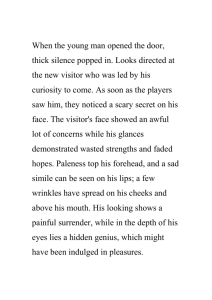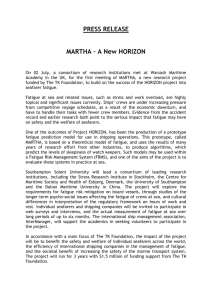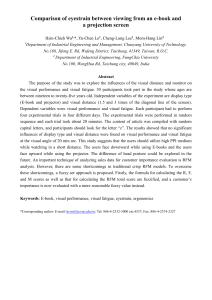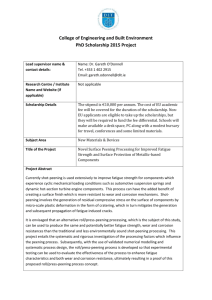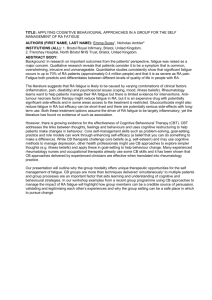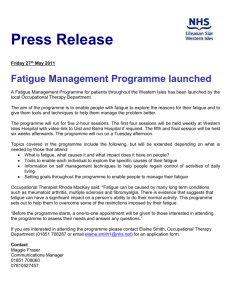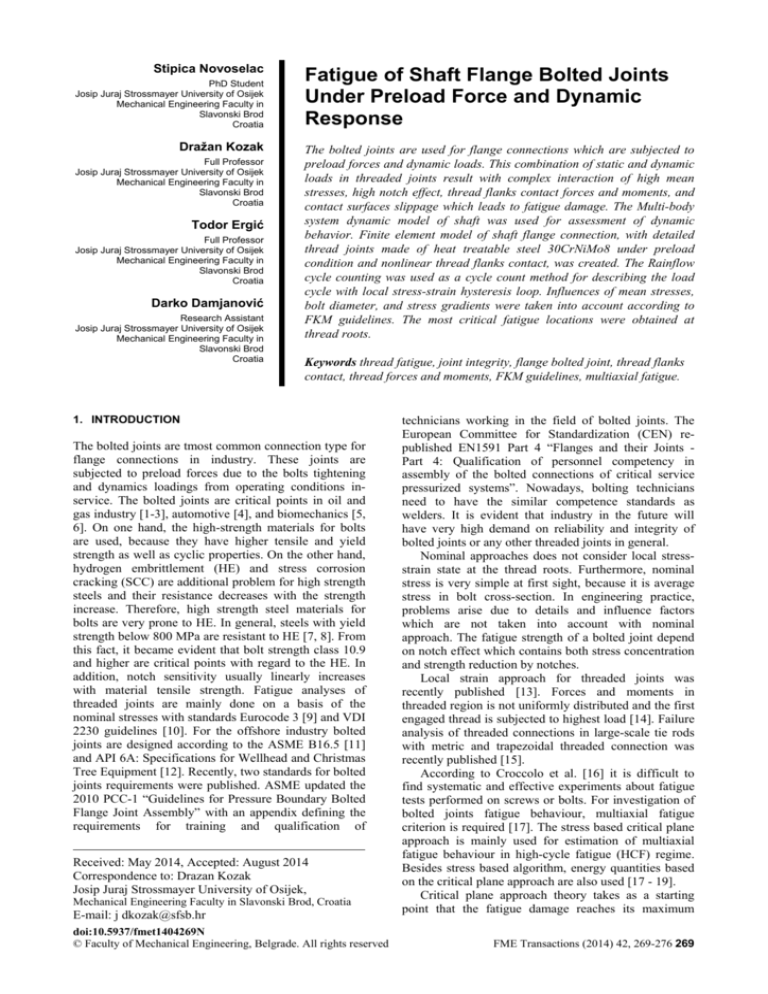
Stipica Novoselac
PhD Student
Josip Juraj Strossmayer University of Osijek
Mechanical Engineering Faculty in
Slavonski Brod
Croatia
Dražan Kozak
Full Professor
Josip Juraj Strossmayer University of Osijek
Mechanical Engineering Faculty in
Slavonski Brod
Croatia
Todor Ergić
Full Professor
Josip Juraj Strossmayer University of Osijek
Mechanical Engineering Faculty in
Slavonski Brod
Croatia
Darko Damjanović
Research Assistant
Josip Juraj Strossmayer University of Osijek
Mechanical Engineering Faculty in
Slavonski Brod
Croatia
Fatigue of Shaft Flange Bolted Joints
Under Preload Force and Dynamic
Response
The bolted joints are used for flange connections which are subjected to
preload forces and dynamic loads. This combination of static and dynamic
loads in threaded joints result with complex interaction of high mean
stresses, high notch effect, thread flanks contact forces and moments, and
contact surfaces slippage which leads to fatigue damage. The Multi-body
system dynamic model of shaft was used for assessment of dynamic
behavior. Finite element model of shaft flange connection, with detailed
thread joints made of heat treatable steel 30CrNiMo8 under preload
condition and nonlinear thread flanks contact, was created. The Rainflow
cycle counting was used as a cycle count method for describing the load
cycle with local stress-strain hysteresis loop. Influences of mean stresses,
bolt diameter, and stress gradients were taken into account according to
FKM guidelines. The most critical fatigue locations were obtained at
thread roots.
Keywords thread fatigue, joint integrity, flange bolted joint, thread flanks
contact, thread forces and moments, FKM guidelines, multiaxial fatigue.
1. INTRODUCTION
The bolted joints are tmost common connection type for
flange connections in industry. These joints are
subjected to preload forces due to the bolts tightening
and dynamics loadings from operating conditions inservice. The bolted joints are critical points in oil and
gas industry [1-3], automotive [4], and biomechanics [5,
6]. On one hand, the high-strength materials for bolts
are used, because they have higher tensile and yield
strength as well as cyclic properties. On the other hand,
hydrogen embrittlement (HE) and stress corrosion
cracking (SCC) are additional problem for high strength
steels and their resistance decreases with the strength
increase. Therefore, high strength steel materials for
bolts are very prone to HE. In general, steels with yield
strength below 800 MPa are resistant to HE [7, 8]. From
this fact, it became evident that bolt strength class 10.9
and higher are critical points with regard to the HE. In
addition, notch sensitivity usually linearly increases
with material tensile strength. Fatigue analyses of
threaded joints are mainly done on a basis of the
nominal stresses with standards Eurocode 3 [9] and VDI
2230 guidelines [10]. For the offshore industry bolted
joints are designed according to the ASME B16.5 [11]
and API 6A: Specifications for Wellhead and Christmas
Tree Equipment [12]. Recently, two standards for bolted
joints requirements were published. ASME updated the
2010 PCC-1 “Guidelines for Pressure Boundary Bolted
Flange Joint Assembly” with an appendix defining the
requirements for training and qualification of
Received: May 2014, Accepted: August 2014
Correspondence to: Drazan Kozak
Josip Juraj Strossmayer University of Osijek,
Mechanical Engineering Faculty in Slavonski Brod, Croatia
E-mail: j dkozak@sfsb.hr
doi:10.5937/fmet1404269N
© Faculty of Mechanical Engineering, Belgrade. All rights reserved
technicians working in the field of bolted joints. The
European Committee for Standardization (CEN) republished EN1591 Part 4 “Flanges and their Joints Part 4: Qualification of personnel competency in
assembly of the bolted connections of critical service
pressurized systems”. Nowadays, bolting technicians
need to have the similar competence standards as
welders. It is evident that industry in the future will
have very high demand on reliability and integrity of
bolted joints or any other threaded joints in general.
Nominal approaches does not consider local stressstrain state at the thread roots. Furthermore, nominal
stress is very simple at first sight, because it is average
stress in bolt cross-section. In engineering practice,
problems arise due to details and influence factors
which are not taken into account with nominal
approach. The fatigue strength of a bolted joint depend
on notch effect which contains both stress concentration
and strength reduction by notches.
Local strain approach for threaded joints was
recently published [13]. Forces and moments in
threaded region is not uniformly distributed and the first
engaged thread is subjected to highest load [14]. Failure
analysis of threaded connections in large-scale tie rods
with metric and trapezoidal threaded connection was
recently published [15].
According to Croccolo et al. [16] it is difficult to
find systematic and effective experiments about fatigue
tests performed on screws or bolts. For investigation of
bolted joints fatigue behaviour, multiaxial fatigue
criterion is required [17]. The stress based critical plane
approach is mainly used for estimation of multiaxial
fatigue behaviour in high-cycle fatigue (HCF) regime.
Besides stress based algorithm, energy quantities based
on the critical plane approach are also used [17 - 19].
Critical plane approach theory takes as a starting
point that the fatigue damage reaches its maximum
FME Transactions (2014) 42, 269-276 269
value on the plane of maximum shear stress amplitude
(τA), and the maximum normal stress (σnmax) relative to
the plane with maximum τA is used to evaluate the
detrimental effect of non-zero mean normal stress [20,
21]. According to the critical plane approach theory,
fatigue damage depends on both τA and σnmax. Detailed
investigation with local approach of stress gradients
influence on bolted joint fatigue behavior was recently
published [22].
In the present study, the fatigue analysis of flange
bolted joints which are subjected to preload forces and
dynamic response was performed. This combination of
static preload forces and dynamic response create
complex interaction of high mean stresses, high notch
effects, and nonlinear contact interactions with slippage
of thread flanks. This in turn lead to fatigue damage.
Multi-body system (MBS) dynamic results of shaft were
used for dynamic loadings. Finite element (FE) model
of shaft flange connection, with detailed thread joints
made of heat treateble steel 30CrNiMo8 was analyzed
for fatigue. Rainflow cycle counting was used as cycle
count method for describing the load cycle with local
stress-strain hysteresis loop. Influences of mean
stresses, bolt diameter, and stress gradients were taken
into account according to the FKM guidelines.
tetrahedral elements with improved surface stress
(Abaqus C3D10I elements) for achieving accurate stress
results on contact surfaces with nuts and bolt heads. The
number of C3D8 elements is 703448 and 42612 of
elements type C3D10I. The total number of nodes is
853838. Thread profile was defined as axi-symmetric
because it has been found that helical effect does not
influence the load distribution [23]. Nonlinear contacts
were modeled with sliding surface contact. Contact
surfaces are shown in Fig. 4. According to the VDI
2230 Guidelines in the case of uncertainty about friction
in the thread flanks and under the bolt head and nut, the
lowest possible coefficient of friction must be selected
[24]. For steel – steel combination in dry state, μ = 0.1 –
0.23 [24]. Therefore, friction coefficient was set to μ =
0.1, as the lowest possible. The flange bolted joints
consist of M10 bolts, strength class 12.9 with metric
standard thread (pitch according to DIN 13-1 and -28,
stress cross section and cross section at minor diameter
according to DIN 13-28, and minimum yield point
according to DIN EN ISO 898-1).
2. MODELING
The first modeling phase included FE model of shaft
with flange for MBS dynamic analysis. For dynamic
analysis, coarse FE mesh was created with bolts
modeled as beam elements. FE model is shown in Fig.
1. The bolt modeling approach with beam elements can
be clearly seen in Fig. 1. Mesh was created with solid
tetrahedral elements (Abaqus C3D10 elements) and
beam elements (Abaqus B31 elements). The Model
consists of 17330 solid and 16 beam elements. Total
number of nodes is 27871. Beam elements are
connected via the kinematic couplings between flange
connection. However, dynamic analysis is not a target
of this investigation. Therefore, only details regarding
the fatigue will be briefly explained.
Figure 2. Fine FE model for fatigue analysis
Figure 3. Bolts and nuts mesh with solid hexahedral
elements for fatigue analysis
Figure 1. Coarse FE model for dynamic analysis
For fatigue analysis, which is a main target of this
investigation, bolts and nuts mesh was created very fine
with solid hexahedral elements (Abaqus C3D8
elements), as shown in Fig. 3. Additionaly, flanges were
also meshed finer than in the dynamic analysis with
270 ▪ VOL. 42, No 4, 2014
During the in-service life of flange bolted joints, first
load is due to the tightening. Bolts preload force (Fp)
was defined according to force at yield point (F0.2) for
M10 bolt, strength class 12.9, with value of F0.2 = 64000
N [24]. Applied preload force was FP = 44800 N. This
value corresponds as 70% of F0.2. Abaqus command
„Bolt Preload“ was used for application of the forces on
FME Transactions
surface in middle of each bolt shank. The tightening of
all bolts was simultaneously introduced in first step of
FE analysis. Further steps were defined with results
from dynamic analysis which contains displacements
and rotations of kinematic coupling master nodes. These
displacements and rotations of master nodes are used for
loadings of fine model for fatigue analysis, as shown in
Fig. 5. Duration of loading is 1.5 s.
(stress ratio R = - 1) and relative stress gradient (χ' = 0)
with survival probability defined at 97.5% is shown in
Fig. 6. The fatigue limit for R = - 1 have a knee-point in
the S-N curve at 2·106 cycles with the slope of k = 12.
Alternating fatigue strength under tension/compression
(R = - 1) is σD,tc = 565 MPa [25].
Figure 4. Contact surfaces
Figure 6. 30CrNiMo8 steel a) Haigh diagram and b) S-N
curve for survival probability of 97.5%
FE analysis was done in Abaqus 6.12 (Simulia,
Providence, RI, USA). The stress tensors with fatigue
influence factors and nonlinear cyclic material
properties were further calculated in the FemFat 5.0
(ECS, Steyr, Austria) software.
3. FATIGUE ANALYSIS
Figure 5. Displacements and rotations of kinematic
couplings master nodes
30CrNiMo8 steel monotonic and cyclic properties
are shown in Table 1.
Table 1. Material cyclic and monotonic properties
Property
Modulus of elasticity, E [MPa]
Poisson coefficient, ν [-]
Tensile strength, Rm [MPa]
Yield strength, R0.2 [MPa]
Cyclic coefficient of hardening, K’ [MPa]
Cyclic exponent of hardening, n’ [-]
Elongation at fracture, A [%]
Value
212000
0.3
1250
1050
2012.5
0.15
9.3
Material properties are defined according to the DIN
EN 10 083-1 for quenched and tempered condition.
Smooth circular specimen diameter is 7.5 mm. S–N
curve for alternating tension/compression loading
FME Transactions
The fatigue calculation starts from known smooth
specimen S-N curve and Haigh diagram with stress
tensors from FE analysis. Furthermore, multiaxial
interaction between stress amplitude tensors and mean
stress tensors was solved with critical plane approach in
combination with the Haigh diagram. Each node with
particular local S-N curve at bolts is calculated from the
specimen cyclic properties and fatigue influence factors,
such as notch effects, diameter, mean stress, mean stress
rearrangement due to local plastification, and statistics
(range of dispersion and survival probability). These all
influences are taken into account at a locally modified
S-N curve and Haigh diagram to obtain correct fatigue
limit at critical areas, because material cyclic properties
are valid for the smooth cylindrical specimen, not
notched structure. If in the loading spectrum of a flange
bolted joints local stress values are in the elasto-plastic
area of material, than mean stress tensors are rearranged
by the means of Neuber-hyperbola rule in the cycle
stabilised stress–strain curve. This means that the
unrealistic high stress values due to the linear-elastic
material definition in FE analysis and stress
concentrations in notches will be rearranged to achieve
realistic nonlinear cyclic material behaviour. Mean
VOL. 42, No 4, 2014 ▪ 271
stress rearrangement was done according to Neuberhyperbola with FemFat PLAST. Haigh diagram was
used to define the most critical cutting plane angle and
the damaging factor for each node on bolted joints. The
plane with maximum damage is assumed as the most
critical for fatigue failure. Cutting plane was defined for
every 10°. The relative stress gradients (χ') and mean
stresses (σM) influences the slope (k), endurance cycle
limit (ND), and fatigue limit (σD) of local S–N curve.
Influence factors of size and statistics influences only
fatigue limit. Results of fatigue safety factors (SF)
against fatigue limit are for constant mean stress in
Haigh diagram:
SF Aall
A
(1)
where σAall is the allowable stress amplitude and σA is
the maximum stress amplitude during fatigue load
spectrum.
The equivalent stress algorithm used for the
multiaxial fatigue failure was scaled normal stress in
critical plane which takes the damaging effect of shear
into account and is recommended for ductile materials
[26]. The algorithm for equivalent stress calculation
makes reduction of the multiaxial stress state to the
equivalent state with a criterion suitable for a ductile
material, such as steel. From the obtained equivalent
stress history in time domain, a Rainflow cycle counting
is applied to identify closed cycles in the stress–strainpath. This means that the resultant loading is saved in a
square 64x64 amplitude/mean stress matrix.
Influence of size was defined with the bolt diamater
of 10 mm. It has been found that the fatigue life reduces
as the bolt nominal size increases [27]. The size
influence factor is determined in accordance with FKMGuidelines [25]. The range of dispersion (TS) is defined
as the ratio of the bolt fatigue strength at survival
probability of PS = 10% to fatigue strength at PS = 90%.
Recommended value for steel is 1.26 [26, 28]. This
value is taken from experiments. Fatigue analysis was
done with high survival probability of PS = 99%. The
statistics applied regarding distribution type is the
Gaussian Log-Normal distribution for the calculation of
statistics influencing variables, both for range of
dispersion and survival probability.
Fatigue limits under bending conditions are always
higher than under the tension/compression. The gradient
support effect was confirmed in research with
tension/compression and bending fatigue experimental
investigations [29, 30]. Gradient support effect is
determined with the relative stress gradient (χ').
According to FKM-Guidelines [25], support factor
can be calculated in dependence from relative stress
gradient values:
for χ' ≤ 0.1 MPa/mm support factor n can be
calculated:
n
R
a G 0.5 m
bG
1 ' 10
(2)
for 0.1 MPa/mm < χ' ≤ 1 MPa/mm support factor n is:
272 ▪ VOL. 42, No 4, 2014
n 1
'
R
a G m
bG
10
(3)
for 1 MPa/mm < χ' ≤ 100 MPa/mm support factor n is:
4
n 1
'
R
a G m
bG
10
(4)
where aG and bG are constants and for the steels are 0.5
and 2700, respectively [25].
According to the FKM-Guidelines [25], mean stress
influence is taken into account with mean stress factor
(KAK,σ), which depends on the type of overloading. It
describes the way how the stress may increase in the
case of a possible overload in-service. Selected type Fl
is when the mean stress (σM) remains the same. Fields of
mean stresses for calculation of the KAK,σ are separated
in four fields. These fields depend on the stress ratio R
or on the mean stress σM. All four fields are described
below.
Field I: R > 1, field of fluctuating compression stress,
where R = + or - ∞ is the zero compression stress.
Field II: - ∞ ≤ R ≤ 0, where R < -1 is the field of
alternating compression stress. R = -1 is the completely
reversed stress, while R > -1 is the field of alternating
tension stress.
Field III: 0 < R < 0.5, field of pulsating (or fluctuating)
tension stress, where R = 0 is the zero tension stress.
Field IV: R ≥ 0.5, field of high pulsating tension stress.
All four fields were marked in Fig. 6 in Haigh diagram.
Calculation for the type of overloading Fl is according
to the following equations.
Field I:
For max M / ( K Eσ WK ) 1/ 1 M σ 2 there is:
K AK,σ
Field II:
For 1 / 1 M σ max
1
1 Mσ
(5)
1/ 1 M σ there
is:
K AK,σ 1 M σ max
Field III:
For 1/ 1 M σ max
3 M σ / 1 M σ
K AK,σ
(6)
2
1 Mσ / 3 Mσ
max
1 Mσ
3
(7)
Field IV:
For max 3 M σ / 1 M σ 2 there is:
K AK,σ
3 Mσ
3 1 M σ
2
(8)
where σmax is the maximum stress.
Mean stress sensitivity is calculated according to the
following equations for normal and shear stress,
respectively:
R
M σ aM m bM
1000
(9)
FME Transactions
M τ f wτ M σ
(10)
where aM and bM are material constants. For steel aM =
0.35 and bM = -0.1. fwτ is shear fatigue strength factor.
steps with dynamic loadings. Magnitude of total
moment due to contact pressure and frictional stress
(MCMTM) is shown on diagram of Fig. 9. From diagram,
maximal obtained value of MCMTM = 877946 N·mm.
4. RESULTS AND DISCUSSION
The stress tensors from FE analysis with bolts
tightening step and further dynamic loadings were
analyzed in time domain to obtain fatigue safety factors,
stress amplitudes, mean stresses, relative stress
gradients, stress ratios, and fatigue limit. The stress
tensors were written only for bolts finite elements from
threaded region and close to the bolt head. The reason
for such approach was to have a reasonable amount of
data and to analyze only most critical areas, because
threaded joints are generally known for their high stress
concentrations, high stress gradients, and fatigue
failures. The Max Principal stress history for the most
critical node at first engaged thread root is shown in Fig.
7. The most critical node is determined with fatigue
analysis. Therefore, this node is of particular interest.
The Max Principal stress distribution for step with
maximal value is shown on cut view of bolt 6. It can be
seen that high stress concentrations occur at first 3
thread roots. It can be also noticed that the stress values
are very high. This is result of linear-elastic material
definition and high notch effect at thread roots. These
values prove the necessity for stress rearrangement by
means of Neuber-hyperbola. Deformation scale for Max
Principal stress distribution on bolt 6 is 25.
Figure 8. Magnitude of total force due to contact pressure
and frictional stress
FIGURE 9. Magnitude of total moment due to contact
pressure and frictional stress
Fatigue results of SF are shown in Fig. 10 for all
bolts and PS = 99%. For each bolt, calculated minimal
SF is placed next to bolt position. Bolt 6 has a lowest
SFmin = 1.39.
FIGURE 7. Max Principal stress history for most critical
node on bolt 6
FIGURE 10. Fatigue safety factors
Magnitude of total force due to contact pressure and
frictional stress (FCFTM) is shown on diagram of Fig. 8.
From diagram, maximal obtained value of FCFTM =
12351 N. It can be noticed that the value of FCFTM after
tightening in first step has slightly decreased over the
The stress amplitudes distribution on bolt 6 is shown
in Fig. 11 a). The distribution clearly shows that the
highest stress amplitudes occur at threaded region of
bolt. Maximal value of σA = 219 MPa was obtained at
first engaged thread root. It can be also noticed that at
FME Transactions
VOL. 42, No 4, 2014 ▪ 273
the nominal section of bolt (i. e., at bolt shank) stress
amplitudes are significantly lower. In middle part
approximately σA = 10 MPa, whereas in area close to
the bolt head σA = 50 MPa. The distribution of fatigue
safety factors is shown in Fig. 11 b). The results show
that the minimal safety factor occur at first engaged
thread with value of SFmin = 1.39. Stress amplitude
distribution and fatigue safety factors are shown in Fig.
12 a) and b), respectively with detailed 3D view on
threaded region.
The results clearly show the difference in most
critical region and nominal region from fatigue point of
view. Relative stress gradient at node with SFmin: χ' =
8.4 MPa/mm. However, on bolt shank χ' = 0.4
MPa/mm. The most critical node in first engaged thread
root have a mean stress σM = 1016 MPa, whereas at bolt
shank σM = 526 MPa. Haigh diagrams for thread root
node and bolt shank node are shown in Fig. 13 a) and
b), respectively. From Haigh diagrams can be seen
difference in stress amplitudes and mean stresses
between thread root and nominal bolt shank. On Fig. 13
a) it is marked how the fatigue safety factor is measured
with the case when mean stress remains the same.
Furthermore, stress ratio of R = 0.7 was obtained for
thread root, whereas node at bolt shank have R = 0.9.
Regarding the fatigue limits at particular area, it is
interesting to observe that thread root fatigue limit is σD
= 303 MPa, whereas σD = 413 MPa for bolt shank.
Lower fatigue limit at thread root is a result of high
notch effect (stress concentration and stress gradients).
The fatigue safety factor at bolt shank is SF = 10.2.
Fatigue safety factors corresponds to so-called knee
point at local S-N curve. In engineering standards and
regulations, the S-N curve knee point is defined as the
transition to infinite life. The S-N curve is generally
limited to 106, 2·106, 5·106, 107 cycles or some other
value depending on the standard or structure (69).
Recent experimental results up to giga-cycles (i. e.,
1·109) shows that there is a further decline of the S-N
curve beyond the knee point at higher cycles. The
fatigue strength decline of ≈ 10% per decade is usually
assumed for engineering practice. Fatigue limit is
usually given by the average alternating stress σD and
the certain survival probability.
Figure 12. Fatigue results a) stress amplitudes and b)
fatigue safety factors over threaded region at bolt 6
FIGURE 13. Haigh diagrams for node at a) first engaged
thread root and b) bolt shank.
Figure 11. Fatigue results a) stress amplitudes and b)
fatigue safety factors at most critical bolt
274 ▪ VOL. 42, No 4, 2014
The further drop of fatigue strength in the high-cycle
range can be considered using S-N curve with fictitious
slopes beyond the knee point of k' = 2k - 1 or 2k - 2
(according to Haibach (56)) depending on material
condition (wrought, cast or welded). Various standards
FME Transactions
and regulations point out (58, 26, 70) that the fatigue
limit does not exist in the case of jointed components
such as press-fits or bolted joints because of fretting,
high temperatures, and/or corrosion (71). Therefore,
fatigue safety factors and reliability for higher number
of cycles should be done with fatigue „limit“
corresponding to that higher number of cycles. For
instance, to determine the fatigue safety factors of
threaded joint for 2·107 cycles, they should be
calculated with decreased fatigue limit value beyond
knee point.
5. CONCLUSIONS
Under the parameters of dynamic analysis, FE, and
fatigue analysis with influence factors of this study, the
following conclusions were drawn concerning the
fatigue of flange bolted joints for survival probability of
PS = 99%:
• From fatigue results, the most critical fatigue
locations were obtained at thread roots,
• Thread roots are exposed to high notch effect with
maximum stress amplitude of σA = 219 MPa and
relative stress gradient of χ’ = 8.4 MPa/mm,
• Obtained local fatigue limit for bolts made of
30CrNiMo8 steel, strength class 12.9, is σD = 303
MPa. This local value is valid only at first engaged
thread root with preload condition of 70% of force at
yield point (F0.2), stress ratio of R = 0.7, and PS =
99%,
• Bolt shank is exposed to much lower stress
amplitudes and notch effect.
ACKNOWLEDGMENT
The authors would like to thank AVL company for
usage of Abaqus and FemFat softwares.
REFERENCES
[1] Esaklul, K.A., Ahmed, T.M.: Prevention of failures
of high strength fasteners in use in offshore and
subsea applications, Eng. Fail. Anal., Vol. 16, No.
3, pp. 1195–1202, 2009.
[2] Sungkon, H.: Fatigue analysis of drillstring
threaded connections, in: Proceedings of The
Thirteenth International Offshore and Polar
Engineering Conference, 25–30.05.2003, Hawaii,
USA, pp. 202-208.
[3] Shahani, A.R., Sharifi, S.M.H.: Contact stress
analysis and calculation of stress concentration
factors at the tool joint of a drill pipe, Mater.
Design, Vol. 30, No. 9, pp. 3615–3621, 2009.
[4] Cho, S.S., Chang, H., Lee, K.W.: Dependence of
fatigue limit of high-tension bolts on mean stress
and ultimate tensile strength, Int. J. Automot.
Techn., Vol. 10, No. 4, pp. 475−479, 2009.
[5] Novoselac, S., Ergić, T., Kozak, D., Sertić, J.,
Pacak, M., Influence of dental implant screw
preload force on high-cycle fatigue (in Croatian),
in: Proceedings of 5th Croatian Society of
Mechanics, 06-07.06 2013, Croatia, pp. 137-142.
FME Transactions
[6] Novoselac, S., Ergić, T., Kozak, D., Baškarić, T.,
Structural durability of dental implants (in
Croatian), in: Proceedings of 6th Croatian Society
of Mechanics, 29-30.05.2014, Croatia, pp. 251-256.
[7] McEvily, A. J.: Atlas of Stress Corrosion and
Corrosion Fatigue Curves, ASM International,
1990.
[8] Bickford, J.H.: An introduction to the design and
behavior of bolted joints. 2nd Ed. Marcel Deckker,
1990.
[9] Eurocode No. 3: Design of steel constructions, Part
1. Beuth-Verlag, Berlin; 1993.
[10] Verein Deutscher Ingenieure, VDI 2230
Guidelines, 2003.
[11] ASME/ANSI B16 – standards of pipes and fittings,
2003.
[12] API Spec 6A, Specification for wellhead and
christmas tree equipment. Washington DC,
American Petroleum Institute, 1996.
[13] Schneider, R., Wuttke, U., Berger, C.: Fatigue
Analysis of Threaded Connections Using the Local
Strain Approach, Procedia Eng., Vol. 2, No. 1, pp.
2357–2366, 2010.
[14] Patterson, E.A., Kenny, B.: A modification to the
theory for the load distribution in conventional nuts
and bolts, J. Strain Anal. Eng. Des., Vol. 21, No. 1,
pp.17–23, 1986.
[15] Duan, W., Joshi, S.: Failure analysis of threaded
connections in large-scale steel tie rods, Eng. Fail.
Anal., Vol. 18, No. 8, pp. 2008-2018, 2011.
[16] Croccolo, D., Agostinis, M., Vincenzi, N.: A
contribution to the selection and calculation of
screws in high duty bolted joints, Int. J. Press.
Vessels Pip., Vol. 96-97, pp. 38–48, 2012.
[17] Fares, Y., Chaussumier, M., Daidie, A., Guillot, J.:
Determining the life cycle of bolts using a local
approach and the Dang Van criterion, Fatigue Fract.
Engng. Mater. Struct., Vol. 29, No. 8, pp. 588–596,
2006.
[18] Liao, R., Sun, Y., Liu, J., Zhang, W.: Applicability
of Damage Models for Failure Analysis of
Threaded Bolts, Eng. Fract. Mech., Vol. 78, No. 3,
pp. 514–524, 2011.
[19] Susmel, L., Tovo, R.: Estimating fatigue damage
under variable amplitude multiaxial fatigue loading,
Fatigue Fract. Engng. Mater. Struct., Vol. 34, No.
12, pp.1053–1077, 2011.
[20] McDiarmid, D.L.: A shear stress based criticalplane criterion of multiaxial fatigue failure for
design and life prediction, Fatigue Fract. Eng.
Mater. Struct., Vol. 17, No. 12, pp. 1475–1484,
1994.
[21] Lazzarin, P., Susmel, L.: A stress-based method to
predict lifetime under multiaxial fatigue loadings,
Fatigue Fract. Eng. Mater. Struct., Vol. 26, No. 12,
pp. 1171–1187, 2003.
[22] Novoselac, S., Kozak, D., Ergić, T., Šimić, I.:
Influence of Stress Gradients on Bolted Joint
VOL. 42, No 4, 2014 ▪ 275
Fatigue Behaviour Under Different Preloads and
Cyclic Loads Ratio. Structural Integrity and Life,
Vol. 14, No. 1, pp. 3-16, 2014.
[23] Chen, J.J., Shih, Y.S.: A study of the helical effect
on the thread connection by three dimensional finite
element analysis, Nucl. Eng. Des., Vol. 191, No. 2,
pp. 109–116, 1999.
[24] Verein Deutscher Ingenieure, VDI 2230
Guidelines, 2003.
[25] Forschungskuratorium Maschinenbau (FKM).
Analytical strength assessment of components in
mechanical engineering, 5th Ed. VDMA Verlag
GmbH, 2003.
[26] ECS Steyr. FemFat 4.8: MAX Manual. St.
Valentin, 2007.
[27] Majzoobi, G.H., Farrahi, G.H., Habibi, N.:
Experimental evaluation of the effect of thread
pitch on fatigue life of bolts. Int. J. Fatigue, Vol.
27, No. 2, pp.189–196, 2005.
[28] Haibach, E., Matschke, C.: Normierte Wöhlerlinien
für ungekerbte und gekerbte Formelemente aus
Baustahl, Stahl u. Eisen, Vol. 101, No. 3, pp. 21-27,
1981.
[29] Papadopoulos, I. V., Panoskaltsis, V. P.: Invariant
formulation of a gradient dependent multiaxial
high-cycle fatigue criterion, Eng. Fract. Mech., Vol.
55, No. 4, pp. 513-528, 1996.
[30] Morel, F., Morel, A., Nadot, Y.: Comparison
between defects and micro-notches in multiaxial
fatigue – The size effect and the gradient effect, Int.
J. Fatigue, Vol. 31, No. 2, pp. 263-275, 2009.
276 ▪ VOL. 42, No 4, 2014
ЗАМОР ВИЈЧАНОГ СПОЈА ПРИРУБНИЦЕ
ВРАТИЛА ПОД ДЈЕЛОВАЊЕМ СИЛА
ПРИТЕЗАЊА И ДИНАМИЧКОГ ОДЗИВА
Стипица Новоселац, Дражан Козак, Тодор Ергић,
Дарко Дамјановић
Вијчани спојеви кориштени за прирубничке спојеве
подвргнути су силама притезања и динамичким
оптерећењима. Наведена комбинација статичких и
динамичких оптерећења у вијчаним спојевима
резултира с комплексном интеракцијом високих
средњих напрезања, високог ефекта зарезног
дјеловања, сила и момената на боковима навоја и
клизањем контактних површина што доводи до
заморног оштећења. Мулти-бодy сyстем динамички
модел вратила кориштен је за одређивање
динамичког понашања. Модел коначних елемената
споја прирубнице вратила с детаљним навојним
спојевима од топлински обрађеног челика
30ЦрНиМо8 креиран је за оптерећења услијед
притезања вијака с нелинеарним контактима.
Раинфлоw бројање циклуса кориштено је за
описивање циклуса оптерећења с локалном петљом
Утјецаји
хистерезе
напрезања-деформација.
средњих напрезања, промјера вијка и градијената
напрезања узети су у обзир према ФКМ
препорукама. Најкритичније локације с обзиром на
замор добивене су у коријенима навоја.
FME Transactions



